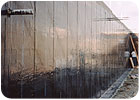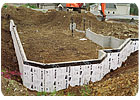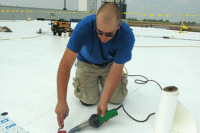
CCW MiraDRI self-adhesive sheet membrane can be used in conjunction with insulated wall forming systems using expanded or extruded polystyrene. (Photo courtesy of Carlisle Coatings & Waterproofing.)
The decline of built-up waterproofing systems in the past decade has led to an increase in the application of single-ply materials. Single-ply materials used in waterproofing consist of both elastomeric and thermoplastic materials. Thermoplastic sheets are available in three compositions: Polyvinyl chloride (PVC), chlorinated polyurethane (CPE) and chlorosulfonated polyethylene (CSPE or Hypalon). The most prominent single-ply waterproofing materials are butyl rubber and specially formulated PVC sheets.

Insulfoam R-Tech insulation products are available in custom and pre-cut forms for virtually every construction purpose, including foundation and slab insulation. (Photo courtesy of Insulfoam, a Carlisle Company.)
Butyl Rubber
Butyl is a synthetic rubber identified as polyisobutylene. It is best suited for below-grade, concealed waterproofing applications. Butyl rubber has gained prominence over other synthetic rubbers as a waterproofing material due to its water absorption properties. Butyl rubber has water absorption rates of 1 percent to 2 percent as compared to EPDM (a popular roofing membrane material), which has water absorption rates of 4 percent. Butyl rubber also has vastly superior vapor permeance: 0.025 perms versus 0.05 perms for EPDM. Both materials compare equally in other categories, except for ultraviolet resistance, in which EPDM is more favorable; however, UV resistance is a property that is not required in below-grade waterproofing applications. Butyl rubber is also more resistant to bacteria, fungi and soil chemicals, which butyl rubber is routinely exposed to in waterproofing applications.The butyl rubber sheets used in waterproofing applications range from 60 to 120 mils in thickness. Butyl rubber waterproofing membranes are suitable for all three waterproofing components: structural slabs, slabs on grade, and foundation walls. Application is primarily in fully adhered assemblies. However, they can be loose-laid on framed slabs and on slabs-on-ground that are over mud mats. Application over concrete substrates requires a smooth surface.
Application on horizontal surfaces, such as framed structural slabs and slabs-on-ground are completed by laying out the sheet, allowing it to relax and applying it into the manufacturers approved adhesive over the substrate. The adhesive application shall be in compliance with the manufacturer’s latest printed specifications. Cover tape is required over all seams on sheets over 60-mils in thickness.
Application of butyl rubber over the mud mat (under the slabs-on-ground) can be completed in a loose-laid application. The sheet is laid out and allowed to relax prior to taping of the seams. Protection boards are required over the membranes to protect them from puncturing. The protection boards shall be approved by the membrane manufacturer for application with their sheet. Application of butyl rubber over vertical surfaces requires full adhesion applications. Application is typically limited to 8 to 10 lifts as backfilling commences.
Flashing for butyl membranes consists of non-vulcanized EPDM sheets, which conform to their backing and later cure to attain the elastic properties of fully cured (vulcanized) materials.
PVC Sheets
Polyvinyl chloride (PVC) sheets used in waterproofing are specially formulated and range from 59 to 120 mils in thickness. The PVC used in waterproofing applications differs from the roofing counterpart in both higher thickness (0.59 to 0.120 mils compared to 0.45 to 0.60 mils) and in chemical composition. The PVC roofing sheets add plasticizers as ultraviolet stabilizers, whereas PVC waterproofing sheets omit plasticizers and provide additives for chemical resistance for algae, alkalines and other soil chemicals.In comparison to the other thermoplastic materials, PVC has distinct advantages that are significant for waterproofing applications. PVC has the lowest permeance and absorption ratings of all the thermoplastic materials. The water absorption rate of PVC is 2 percent, whereas chlorosulfonated polyethylene (CSPE or Hypalon) and other thermoplastic materials have significantly higher absorption and permeance ratings.
The PVC sheets are typically reinforced with non-woven glass fiber felts, which contribute to the material’s high tensile strength and puncture resistance. The main advantage of the PVC sheets is the ability to heat weld the seams, which provides seam strengths equivalent to welded steel.
PVC waterproofing membranes are suitable for all three waterproofing components: structural slabs, slabs on grade, and foundation walls. Application is primarily in fully adhered assemblies. However, they can be loose-laid on framed slabs. Application over concrete substrates requires a “floor quality” steel trowel finish for fully adhered applications.
Application on horizontal surfaces, such as framed structural slabs and slabs-on-ground, is completed by laying out the sheet, allowing it to relax and applying it into the manufacturer’s approved adhesive over the substrate. The adhesive application shall be in compliance with the manufacturer’s latest printed specifications. Seams are heat welded using approved hot air guns that supply temperatures above 1,000 degrees Fahrenheit.
Application of PVC over the mud mat (under the slabs-on-ground) can be completed in a loose-laid application. The sheet is laid out and allowed to relax prior to welding of the seams. Protection boards are required over the membrane to protect them from puncturing. Asphalt based protection boards cannot be used over PVC sheets. High-density polyethylene (HDPE) film or another PVC sheet in combination with an insolating layer of polypropylene geotextile is required to prevent damage of the PVC sheet from asphalt hydrocarbons.
Application of PVC sheets over vertical surfaces can be completed by fully adhering the PVC sheet to mechanically attached thermoplastic discs. In this process, the application is divided into two operations. First the mechanical anchors are installed into the vertical substrate and then the PVC sheet is applied. PVC is flashed with the same reinforced sheet that is used as the waterproofing membrane.
Chlorosulfonated Polyethylene
Chlorosulfonated polyethylene (CSPE), most commonly referred to as Hypalon, is a synthetic rubber membrane that is formulated around prime polymers that are assisted by a blend of pigments and fillers. The main polymer is chlorinated polyethylene (CPE) blended with an occasional chlorosulphonyl group instead of chlorine. The chlorosulphonyl groups are cross-linked into the polyethylene molecules of the adjacent chains, which form a more rigid thermal-set structure after curing. The other ingredients include, but are not limited to, CaCO (filler), TiO (for whitening and UV resistance), MgO (for cross linking and color stabilizing), processing aids, antistat and antioxidant compounds, and epoxy based curing agents.CSPE is classified as a non-vulcanized elastomeric because the material has rubber-like characteristics. These membranes have the capacity to stretch under stress and return to their original state once the stress is removed. The non-vulcanized membrane is processed in an uncured state; curing begins once the material is exposed to the elements of sunlight, heat or moisture. The vulcanization process occurs when the molecular structure becomes permanently fixed. Once the material has cured, all seams must be completed using an adhesive. Due to this fact, it is advisable that all flashing work and seams are completed the same day. This type of adhesion method is inferior to heat welding and may not provide long term waterproofing performance. Prior to curing, seams can be completed using a solvent or by hot air welding.
CSPE sheets are manufactured through the calendering process by applying the formulated polymer to a reinforcement sheet. For mechanically fastened systems, the reinforcement sheet is typically a polyester mat. Mineral fiber or felt backing sheets are typically used for fully adhered systems. The fully adhered sheets can be attached to the substrate with either latex adhesive or modified asphalt. Membranes are available in thicknesses of 30 to 60 mils.
KEE with Coal Tar
One of the manufacturers of waterproofing systems provides an elastomeric sheet membrane that is manufactured in a process that blends an Elvaloy KEE polymer with coal tar. The sheet is reinforced with dispersed polyester fibers. The key advantage of the system is that it is fully compatible with coal tar and can be applied directly over coal tar systems or concrete substrates laced with coal tar residue. It also provides the long-term weathering capabilities of coal tar with applications as self-adhered sheets or in a VOC-free adhesive. Application is hot asphalt is also available.The other advantage of the membrane is that it is resistant to environmental, chemical and biological attack. The water absorption rate is less than 0.1 percent, which makes the product extremely suitable for waterproofing applications.
